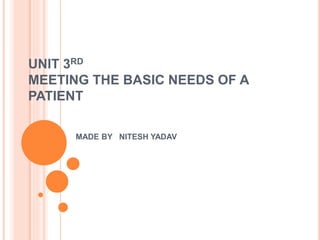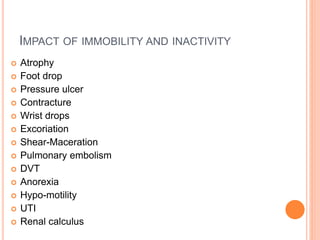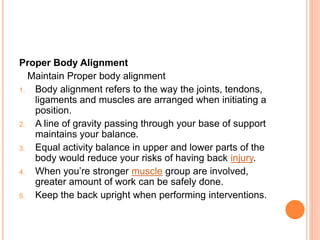UNIT 3RD FUNDAMENTAL.pptx
- 1. UNIT 3RD MEETING THE BASIC NEEDS OF A PATIENT MADE BY NITESH YADAV
- 2. PHYSICAL NEEDS ïĒ Basic Needs of a Patient:- 1. Physiological Needs: - Food, elimination, rest, sleep exercise, recreation and psychological. 2. Essential Needs: - As air O2 administration, life saving measures. 3. Protective Needs: - Safety, security, love, regards, need of belonging. 4. Needs of self recognition: - Identification. 5. Spiritual Needs: - All patients free to worship their God to their choices. 6. Psychological Need: To avoid stress and strain occurred due to sickness. ïĒ ïĒ
- 3. ïĒ 7. Communication Need. 8. Elimination Need: - Need of urination & defecation. 9. Rest &Sleep: - To have physical, mental rest comfortable environment, comfortable bedding and patient should have sound sleep to avoid tension. 10. Exercise: - Physical movement to gate normal flow and muscular tone by the body movements. 11. Recreation: - To divert the patient's mind from the state of illness, the recreation can be helpful by indoor games or T.V. Radio etc, Music reading etc.
- 4. BODY MECHANICS ïĒ Body mechanics involves the coordinated effort of muscles, bones, and the nervous system to maintain balance, posture, and alignment during moving, transferring, and positioning patients. ïĒ Definition Body mechanics is a broad term used to denote an effort coordinated by the muscles, bones and nervous system. It can either be good or bad and can be directly related to the occurrence of back pains.
- 5. PURPOSE ïĒ To maintain good balance. ïĒ To reduce the energy required. ïĒ To avoid excessive fatigue. ïĒ To avoid skeletal injuries. ïĒ To avoid muscles strains or tears. ïĒ To avoid injury to the patient. ïĒ To avoid injury to assisting staff members.
- 6. PRINCIPLES 1. The wider the base of support, the greater the stability. 2. The lower the centre of gravity, the greater the stability. 3. The equilibrium of an object is maintained as long as the line of gravity passes through its base of support. 4. Facing the direction of movement prevent abnormal twisting of the spine. 5. Dividing balanced activity between arms and legs reduces the risk of back injury. 6. It is easier to pull, push or roll an object then it is to lift it.
- 7. 7. Movement should be smooth and coordinated rather than jerky. 8. Reducing the force to work reduced the risk of injury. 9. Maintaining good body mechanics, reduces fatigue of the muscles groups. 10. Moving an object on a level surface require less effort. 11. Alternating periods of rest and activity help reduce fatigue.
- 8. IMPORTANCE What exactly are body mechanics and why are they important? The reason for using proper body mechanics is mainly to avoid: ïĒ Musculoskeletal strain ïĒ Injuries to members of the staff ïĒ Injury to the client ïĒ Fatigue
- 9. RULES These are different rules that apply when you transfer or move your patients to protect your back: ïĒ Keep the lower portion of your back in its normal position at all times. ïĒ Move as close to the patientâs bed as you can. ïĒ Donât twist your body. Always do a side step or a pivot. ïĒ Set your feet into a comfortable and solid wide base of support when lifting. ïĒ Keep your abdominal muscles contracted, bow slightly using the hips and squat. ïĒ Keep the head upright and hold your shoulders up. ïĒ Pushing up from the knees and using your own momentum would help you lift the patient.
- 10. IMPACT OF IMMOBILITY AND INACTIVITY ïĒ Atrophy ïĒ Foot drop ïĒ Pressure ulcer ïĒ Contracture ïĒ Wrist drops ïĒ Excoriation ïĒ Shear-Maceration ïĒ Pulmonary embolism ïĒ DVT ïĒ Anorexia ïĒ Hypo-motility ïĒ UTI ïĒ Renal calculus
- 11. TECHNIQUES Here are the different principles to be a nurse with proper body mechanics: Stable Center of Gravity Maintain a stable center of gravity to evenly distribute your body weight 1. Keep your center of gravity low. 2. Greater balance is met with a low center of gravity. 3. Flex your knees and keep your body straight rather than bending.
- 12. Wide Base of Support Maintain a wide base of support 1. Having a wide base of support gives your body more stability. 2. Spread your feet apart to a reasonable distance. 3. Flex your knees to move the center of gravity closer to the base of support.
- 13. Proper Body Alignment Maintain Proper body alignment 1. Body alignment refers to the way the joints, tendons, ligaments and muscles are arranged when initiating a position. 2. A line of gravity passing through your base of support maintains your balance. 3. Equal activity balance in upper and lower parts of the body would reduce your risks of having back injury. 4. When youâre stronger muscle group are involved, greater amount of work can be safely done. 5. Keep the back upright when performing interventions.
- 14. Moving Clients Here are some guidelines into how to properly move clients and other objects on the work area using proper body mechanics: Pushing 1. Stay close to the subject being pushed. 2. Place one foot in front of the other 3. Place the hands on the subject, flex your elbows and lean to the subject. 4. Place the weight from your flexor to the extensor portions of your leg. 5. Apply pressure with the use of your leg muscles. 6. To prevent fatigue, provide alternate rest periods.
- 15. Pulling 1. Stay close to the subject being pulled. 2. Place one foot in front of the other 3. Hold the subject, flex your elbows and lean your body away from the subject. 4. Shift your weight away from the subject. 5. Avoid any unnecessary movements. 6. To prevent fatigue, provide alternate rest periods.
- 16. Lifting and Carrying 1. Be on a squat position facing the subject. 2. Hold the subject and tighten your center of gravity. 3. Use your dominant leg muscles when lifting. 4. Hold the subject at waist height and close to the centre of gravity. 5. Keep your back erect.















